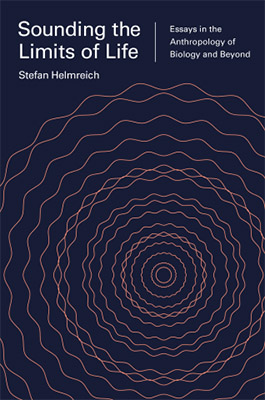I was first introduced to the work Stefan Helmreich, an anthropologist of science at MIT, as a first year PhD student. As an STS student, I’ve always been intrigued by different methodologies used within the field, and I was compelled by Prof. Helmreich’s ethnography of microbial oceanographers Alien Ocean and its affective, narrative quality and engagements with various traditions of thought. Our conversation below covers Professor Helmreich’s research, its relevance to the contemporary sociopolitical landscape, and the future of STS and anthropology of science, with a particular focus on the study of race, sound, biology and the arts.
AC: You’re a prolific anthropologist of the life sciences/biology, but you are also a sound studies scholar. How do those two domains of interest interact for you in your research, or have they always been intertwined for you? Do they influence your methodological choices?
SH: I arrived into conversations on the social study of biology in the 1990s, when much of it was dedicated to the work of critiquing sociobiology and its genres of genetic determinism. People like Dorothy Nelkin, Sarah Franklin, Evelyn Fox Keller, Donna Haraway, Troy Duster, Valerie Hartouni, and Richard Doyle were also starting to call attention to the strangely disembodied approach to “life” that was coming to characterize much early genome-age bioscience. My first book, Silicon Second Nature, was very much in those conversations — seeking to query reductivist information theoretic visions of evolution. A range of work, primarily from feminist and antiracist scholars, sited in history, philosophy, anthropology, and sociology of biology, has since the 1990s had great success in directing scholarly attention to embodiment and materiality. And many biosciences themselves are now, interestingly enough, reorienting themselves in something like a parallel way – toward epigenetics, metabolomics, the microbiome, and more (though not without new kinds of environmental reductionism sprouting up from time to time). Attention to embodiment and biology opened up for many of us — and certainly for me — questions to do with phenomenology and sensing. How might we understand biology through understanding the sensorial worlds of organisms? Sound was one way in. A key paper for me was Sophia Roosth’s 2009 Critical Inquiry essay, “Screaming Yeast: Sonocytology, Cytoplasmic Milieus, and Cellular Subjectivities,” one of the first to bring sound studies and anthropology of biology together.
It’s really interesting that you bring up the efforts in the 1990s to critique biological determinism/reductionism. Do you feel like biological determinism/reductionist thought is less abundant these days, or has it changed form?
That’s a good question. I think that genetic reductionism has done some shapeshifting, so that while the complexly bodied entities/processes known as the microbiome and epigenetics are newly in vogue, it is also the case that genetic genealogy and genetic ancestry-testing enterprises have doubled-down on the “DNA mystique” (as Nelkin and Lindee called it back in 1995). The social life of genetic genealogy is really complex, of course, with unsteady reductionisms being woven onto unexpected and generative community and identity projects and work, as scholars like Alondra Nelson and Kim TallBear have documented and theorized, for Afrodiasporic and Native American communities respectively.
Sometimes, from a certain perspective, it does seem that biological determinism/reductionism seems to be enjoying widespread popularity again, with “race realism” and new gender essentialist thought and similar discourses that have found support in the current political climate. How do you see the future shape up in this particular area and with these particular tensions?
Yikes! I’m not sure. The current political moment in the US is weirdly time-slippy, heterochronic. On the one hand, we have a US being led by a White House that wants to roll back the clock to circa 1960 white supremacist hetero-patriarchy. On the other hand, we have contemporary sex/gender/sexuality politics moving into antireductionist trans and non-binary spaces that take at least some of their cues from utopian queer SF futures. What time are “we” in? Thinking about the meaning of “climate” as “the prevailing influence or environmental conditions characterizing a group or period” (Merriam-Webster), I’d say that we’re in a heterotopic, heterochronic climate, a time-space of denial and change all at once. STS has to track both.
On race: I was upset to see a piece in the New York Times on March 23 of this year entitled “How Genetics Is Changing Our Understanding of Race,” which, under the guise of offering a new and more complex accounting of the relation between genetics and race, simply restated what looked to me like careless and essentialist race realism. I was heartened that the biological anthropologist Jon Marks wrote a response and critique — “There’s an arrogant anti-intellectual hereditarian at Harvard who isn’t Steven Pinker! Who would have thunk it?” — pretty quickly. Biological reductionism just seems to keep coming back and we need to continue to fight it.
Picking up your original provocation to do with sound, maybe it would be interesting to think of this contemporary moment terms of sound, or, more traditionally, music. What does this moment sound like musically, how can music be an X-ray into new biopolitics? Maybe listen to the work of NON, one of the more compelling musical outfits out there these days, trying to decolonize and further queer canonical club music, folding new accounts of embodiment, information, and mobility/exile into as-yet-unmapped sorts of sound spaces.
Do you think sound, music itself, that is creating and/or curating music, can be a feasible and potent research methodology for STS/anthropology of science itself? Or more broadly, how can STS/anthropology of science use arts-based methodologies?

Cover image courtesy of Princeton University Press.
That’s a really interesting topic, STS-y music! Certainly there are lots of musical artists whose works directly engage with STS themes — the first data point that comes to mind is Janelle Monáe, whose 2010 ArchAndroid album (and Metropolis before that, and Electric Lady after that) offers an Afrofuturist meditation on cyborg identity, multiplicity, sexuality, racialization, liberating/oppressive technology. There are many, many other foremothers here, too: Pauline Oliveros, Walter/Wendy Carlos, and really importantly, Laurie Anderson, whose 1982 album Big Science meditates on American technological power, on relationships mediated through and delegated to artificial agents, and a lot more. It was way, way ahead of its time. Then there’s tons of new stuff… check out pointers at places like WYV’s Intersectional Feminist Media and follow TUF.
I suspect we could generate playlists for lots of STS topics — computers, biomedicine, media networks, embodiments — and could find pieces that do analytical work in their technique, composition, or presentation in addition to their lyrics. That would be a really interesting project for people in the STS community to undertake. In Sounding the Limits of Life, my 2016 book of essays, I played with the idea of a book soundtrack, something that could evidence and extend the arguments I developed in the collection. Princeton University Press provided a link from my book website to a SoundCloud collection I curated.
I don’t really fully know what readers/listeners made of it. I’ve got lots of other audio/music/sound files elsewhere, too — though I would be interested in how other people think through all this, think about making arguments through audio. There’s lots of new critical race theory sound studies these days, too — from Jennifer Lynn Stoever’s The Sonic Color Line, to Louis Chude-Sokei’s The Sound of Culture: Diaspora and Black Technopoetics, and much, much more.
How can I forget Monaé? She seems to be developing her work based on cyborg identities and Afrofuturist themes. It makes me wonder, why is it that cyborg theory is the aspect of STS “canon” (I use that word cautiously) is the one with most popular appeal? The idea of “popular STS” gives me mixed feelings, but I really like what is happening with Monaé’s work and the Afrofuturist movement in general. Do you see promises and perils in uses of STS ideas in broad cultural conversations like this? I love your idea of a book soundtrack, and it looks like with music/music videos are gateway drugs for people into STS-allied concepts.
That’s a good question about the popularity of the cyborg figure as a “gateway” figure to STS. Certainly back when Donna Haraway wrote the cyborg manifesto, there were popular culture references upon which she (and her readers) depended … movies like Terminator or Blade Runner. Maybe it’s the literalness of the human-machine meeting that makes the cyborg such a potent theoretical figure as well as popular totem? Are there perils as well as promises in the cyborg image in popular culture? Certainly, yes, particularly in first-person shooter video games! … Maybe I’ll retreat back to cyborgs in music, though, which I’m going to wager are more politically interesting … I think of Kraftwerk’s “Man/Machine,” Björk’s “All is Full of Love,” MF Doom, Drexciya… OK, this is getting kinda listy.
So, what are about your current research projects? I would love to know how they are informed by all these other things you’ve already mentioned!

Image from the public domain
I’ve been thinking about ocean waves — and thinking about how oceanographers, coastal engineers, and mathematicians grapple with waves as entities at once manifestly material and analytically abstract. Waves, known through fieldwork at sea, modeling in the lab, and, increasingly, computer simulation, might, I think, be usefully read as media: material forms that relay information — oceanic, climatic, anthropogenic — to scientists and their publics. I’ve been doing fieldwork at the Scripps Institution of Oceanography, at the US National Weather Service, places like that, trying to get my head around how waves, in the age of climate change, can be understood as emissaries of ocean-borne transformation and emergency, symbolizing and materializing forces generated or amplified by human action, or inaction. The topic of waves, of course, goes all over the place, so I keep getting distracted by non-ocean waves — like sound waves, gravitational waves, cardiac and brain waves, waves of social change …
What do you see as the future of STS/anthropology of STEM? Do you feel it will have policy and sociopolitical implications beyond the academy? How can STS/anthropologists of STEM do outreach on this regard?
The future is topical, and theory will follow … the anthropology/STS of algorithms, of toxicity, of climate, of migration infrastructures — these are all vital matters to attend to politically and intellectually and will continue to test our analytics of scale, causality, and agency. Policy implications? The critical work of STS scholar and mathematician Moon Duchin at Tufts University on the geometry of gerrymandering comes quickly to mind as the sort of public and policy-aimed STS we badly need. Science-and-technology-minded intervention? I think of environmental scientist and STS scholar Max Liboiron and her Civic Laboratory for Environmental Action Research at Memorial University of Newfoundland, dedicated to anti-colonial feminist work on marine pollution. Outreach, I think, works best around very specific questions, places, politics, communities, and technosciences of concern, always mindful of and awake to how inequalities cross-hatch access, expertise, and plans for livable futures.
Thank you for your time Prof. Helmreich!
Happy to chat!
